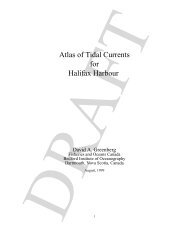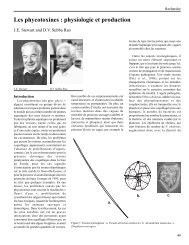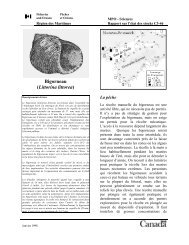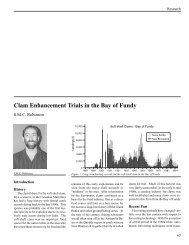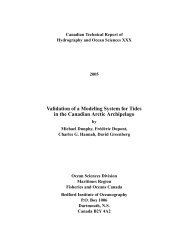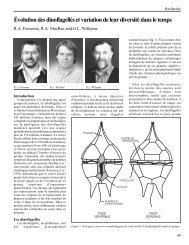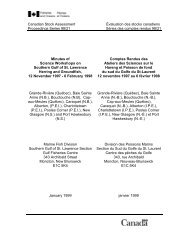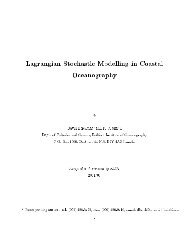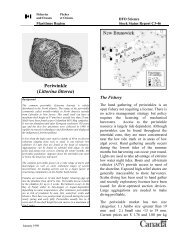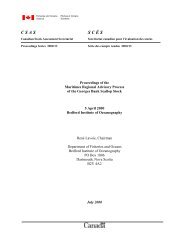bedford institute of oceanography 2001 in review - Région des ...
bedford institute of oceanography 2001 in review - Région des ...
bedford institute of oceanography 2001 in review - Région des ...
You also want an ePaper? Increase the reach of your titles
YUMPU automatically turns print PDFs into web optimized ePapers that Google loves.
SCIENCE ACTIVITIES / Ocean SciencesPacific Water <strong>in</strong> the North Atlantic Ocean- E. P. JonesThe earth’s water cycle shapes our climate and susta<strong>in</strong>s life on earth.Water evaporates from the oceans <strong>in</strong>to the atmosphere, is transportedover wide regions, falls as ra<strong>in</strong>, and snow and returns to the oceanseither directly or via rivers. The oceans are not, however, merely apassive provider <strong>of</strong> water vapor to the atmosphere. Ocean dynamicsare controlled by seawater density, which <strong>in</strong> turn depends on the saltcontent and temperature <strong>of</strong> seawater. Through density, the oceans aregreatly affected by how, when, and where freshwater enters and leavesthe ocean through evaporation, precipitation, and run-<strong>of</strong>f.In arctic regions, freshwater figures strongly <strong>in</strong> the formation <strong>of</strong>dense water that s<strong>in</strong>ks <strong>in</strong>to the deep ocean as part <strong>of</strong> thermohal<strong>in</strong>ecirculation or the Global Conveyor Belt (Figure 1). As ice is formed,freshwater is extracted from seawater, and the excluded salt dra<strong>in</strong>sfrom the ice as br<strong>in</strong>e to form dense water. This denser water formsthick mixed layers <strong>in</strong> the surface ocean or over shallow shelves trigger<strong>in</strong>gdense plumes that flow down the cont<strong>in</strong>ental slopes <strong>in</strong>todeeper water. In some regions, these waters are dense enough to penetrateto the lowest depths <strong>of</strong> the ocean; however, too much freshwater<strong>in</strong> the surface layers might <strong>in</strong>terfere with this process. The GreenlandSea is presently the source <strong>of</strong> much <strong>of</strong> the northern hemisphere’s deepwaters feed<strong>in</strong>g the Global Conveyor Belt. Both freshwater from riversenter<strong>in</strong>g the Arctic Ocean, and ice produced with<strong>in</strong> it, are exported tothe Greenland Sea and can affect its deep convection processes. Thefreshwater budgets <strong>in</strong> arctic regions are <strong>of</strong> direct relevance to theunderstand<strong>in</strong>g and prediction <strong>of</strong> changes <strong>in</strong> thermohal<strong>in</strong>e circulationand hence to global climate.The North Atlantic is the saltiest <strong>of</strong> the world’soceans while the North Pacific is the freshest.The Arctic Ocean provi<strong>des</strong> a pathway thatmoves freshwater from the Pacific Oceanto the North Atlantic Ocean as lowsal<strong>in</strong>ity surface water. This source <strong>of</strong>freshwater is comparable <strong>in</strong> volumeto river run<strong>of</strong>f.Pacific water enters the ArcticOcean through the shallow (50 mdeep) Ber<strong>in</strong>g Strait. Atlantic waterflows along the northern coast <strong>of</strong>Norway,enter<strong>in</strong>g the Arctic Oceanthrough the much deeper FramStrait. Pacific and Atlantic waterspartially mix with<strong>in</strong> the ArcticOcean, but with the Pacific water be<strong>in</strong>gless dense (less sal<strong>in</strong>e) than the Atlanticwater, it rema<strong>in</strong>s conf<strong>in</strong>ed <strong>in</strong> the Arcticsurface layers with<strong>in</strong> the bas<strong>in</strong>s adjacent toNorth America. In addition to their different sal<strong>in</strong>ities,the two source waters haveother properties that dist<strong>in</strong>guishone from the other. In particular,they have different relationships20 / BIO-<strong>2001</strong> IN REVIEWFigure 1. The Global Conveyor Belt represent<strong>in</strong>g global thermohal<strong>in</strong>e circulation <strong>in</strong> theArctic and Atlantic oceans (thanks to Greg Holloway). Warm water flows to polarregions, transport<strong>in</strong>g heat and eventually becom<strong>in</strong>g cooled and made dense enoughto s<strong>in</strong>k to deep waters and flow south. Upwell<strong>in</strong>g <strong>in</strong> equatorial regions closes the loop.Figure 2. Nitrate-phosphate relationships show<strong>in</strong>g the dist<strong>in</strong>ction between waters <strong>of</strong>Atlantic and Pacific orig<strong>in</strong>s. Pacific water has less nitrate relative to phosphate thandoes Atlantic water.between their dissolved nitrate and phosphate concentrations that haveenabled us to trace the pathway <strong>of</strong> Pacific water through the ArcticOcean <strong>in</strong>to the North Atlantic Ocean (Figure 2).Two processes affect nutrient concentrations <strong>in</strong> the oceans.Photosynthesis reduces carbon, nitrate, and phosphate concentrations<strong>in</strong> the ocean and <strong>in</strong>creases oxygen concentrations. Decayreverses this process, <strong>in</strong>creas<strong>in</strong>g carbon (carbon dioxide), nitrate, andphosphate concentrations, and decreas<strong>in</strong>g oxygen concentrations.S<strong>in</strong>ce photosynthesis utilizes these components<strong>in</strong> fixed ratios, the relationships betweennitrate and phosphate are ma<strong>in</strong>ta<strong>in</strong>ed <strong>in</strong> awater mass that has not mixed withanother one. By observ<strong>in</strong>g the nitrateand phosphate concentrations, wehave been able to del<strong>in</strong>eate boundariesand mix<strong>in</strong>g regions betweenthe source waters <strong>in</strong> the near surfacewaters <strong>of</strong> the Arctic Ocean. This hasenabled us to <strong>in</strong>fer the circulation<strong>of</strong> near-surface water (Figure 3).Once hav<strong>in</strong>g entered the ArcticOcean, Pacific water is not conf<strong>in</strong>edto it. Us<strong>in</strong>g nutrient concentrationsas tracers, we f<strong>in</strong>d Pacific water well tothe south <strong>in</strong> the Atlantic sector. Nearsurface water (typically the top 200 m)exits the Arctic Ocean through the CanadianArctic Archipelago and through Fram Strait tothe west <strong>of</strong> Greenland. Our analyses show thatmuch <strong>of</strong> the water flow<strong>in</strong>g throughthe Canadian Archipelago is <strong>of</strong>Pacific orig<strong>in</strong>. In Barrow Strait andJones Sound almost all is <strong>of</strong> Pacific



